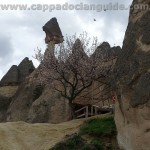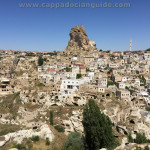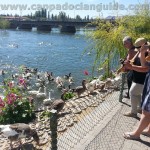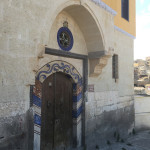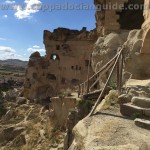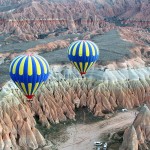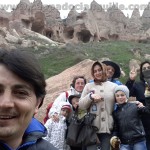By the end of the 2nd century a large Christian community had formed in Cappadocia. It is Known that there were two bishoprics at that time; one in Kayseri ( Cesaria) Cappadocia, which, for a long time, continued to be a Christian Center in the region and the other in Malatya. In the 3rd century, priests wiyh good character changed the region into a lively centre of Christian Activity.
In the 4th century Cappadocia became known as the land of the three saints; The Great St. Basil, Bishop of Kayseri; his brother St. Gregory of Nyssa, and St. Gregory of Nazianus. These three men created a new unity in Chirstian thought, and many of St. Basil’s thoughts and actions are still important today.
An example of his doctrine is the advice to Christian with one piece of bread in a famine. He said that a Christian should give half of his bread to a fellow believer and trust in God to take care of him.
St. Basil founded small, secluded settlements far away from villages and towns. Daily worship was carried out under the supervision of a preacher.
These groups were not, however, privileged groups separated from the community like similar communities in Egypt and Syria. St. Basil is important in that he introduced worship withn the community in the churches of Cappadocia. Göreme Open Air Museum is the place where this kind of religious education was started. The same model was then introduced in Soğanlı, Ihlara and Açıksaray.
Church Architecture in Goreme
The one nave barrel vaulted plan common for Göreme’s churches was the most convenient architectural style for the religious communities and those living in seclusion in the area. These buildings were also seen as suitable areas for graves. The transversal rectangular plan originated in the Mesopotamia, and it is likely that these buildings were constructed for groups of foreigners settling in the area. In Göreme, the only church built with two naves is the church of St. Eustathios, however, the churches in Soğanlı and Ihlara quite often feature two naves. Buildings according to the basilica plan with three naves are also rare in Göreme, this being a preferred technique for the Bishopric churches such as Durmuş Kadir. These churches were big and the architecture was very ornate, and for this reason this style was not popular in rocky areas.
Cave Churches in Goreme Open Air Museum
Chapel of St. Basil
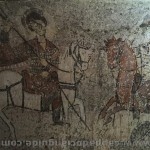 This church is situated at the entrance to the Goreme Open Air Museum. Graves are to be found in the columned narthex area. The nave is transversally rectangular and barrel vaulted, and has three apses situated on the left, long side of the rectangular nave, The church dates back to the 11th Century.
This church is situated at the entrance to the Goreme Open Air Museum. Graves are to be found in the columned narthex area. The nave is transversally rectangular and barrel vaulted, and has three apses situated on the left, long side of the rectangular nave, The church dates back to the 11th Century.
The Scenes of St. Basils Chapel = Portrait of Jesus, Portrait of Mary and Baby Jesus, St. Theodore, St. George, St. Demetrius and Two Female Saints.
Elmalı (Apple) Church
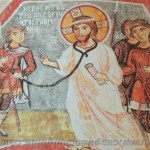 Apple Church featuring four columns, nine domes and three apses is of the closed cruciform type. Access to the church is through a tunnel on the north side. The original decorations in Apple Church consist of geometrical designs and crosses painted in red ochre directly onto the rock. Apple Church dated back to the mid 11th century.
Apple Church featuring four columns, nine domes and three apses is of the closed cruciform type. Access to the church is through a tunnel on the north side. The original decorations in Apple Church consist of geometrical designs and crosses painted in red ochre directly onto the rock. Apple Church dated back to the mid 11th century.
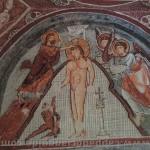 The Scenes of the Apple Church = Deesis, Nativity, Adoration of the Magi, Baptism, Raising of Lazarus, Transfiguration, Entry into Jerusalem, Last Supper, Betrayal of Judas, Way of the Cross, Crucifixion, Entombment, Anastasis, Women at the Tomb, Ascension and portraits of the saints. There are also scenes from the OLD TESTAMENT such as the Hospitality of Abraham and Three Young Men in the Fiery Furnace.
The Scenes of the Apple Church = Deesis, Nativity, Adoration of the Magi, Baptism, Raising of Lazarus, Transfiguration, Entry into Jerusalem, Last Supper, Betrayal of Judas, Way of the Cross, Crucifixion, Entombment, Anastasis, Women at the Tomb, Ascension and portraits of the saints. There are also scenes from the OLD TESTAMENT such as the Hospitality of Abraham and Three Young Men in the Fiery Furnace.
Yilanli (Snake) Church of St. Onophrios
 The main section is transversally rectangular and barrel vaulted, whereas the extended space to the south, which houses the graves,has a flat ceiling. The apse was hollowed out of the long wall on the left and the church was left uncompleted. The entrance to the church isfrom the north. Portraits of the rspected sainst of Cappadocia are on either side of the vault. The church dates back to the 11th century.
The main section is transversally rectangular and barrel vaulted, whereas the extended space to the south, which houses the graves,has a flat ceiling. The apse was hollowed out of the long wall on the left and the church was left uncompleted. The entrance to the church isfrom the north. Portraits of the rspected sainst of Cappadocia are on either side of the vault. The church dates back to the 11th century.
 Scenes: Opposite the entrance is a portrait of Jesus holding the Bible in his left hand. The donor of the chruch is pictured beside Jesus. On the east side of the vault are St. Theodore, and Helena holding the True Cross with her son Constantine the Great. On the west of the vault is the longhaired, naked St. Onuphoius behind a palm tree, with St.Thomas in a sanctifying position beside him, ans St. basil holding a book.
Scenes: Opposite the entrance is a portrait of Jesus holding the Bible in his left hand. The donor of the chruch is pictured beside Jesus. On the east side of the vault are St. Theodore, and Helena holding the True Cross with her son Constantine the Great. On the west of the vault is the longhaired, naked St. Onuphoius behind a palm tree, with St.Thomas in a sanctifying position beside him, ans St. basil holding a book.  In the first century AD people calling themselves “Hermits” lived in seclusion in the Egyptian deserst. They dedicated themselves to religion. In the 4th century, St. Paphnutius traveled to Egypt to learn about the hermits’ way of life, and there he met St. Paphnutius helped St. Onuphrius while he was dying, as he was the best example of moral values and self control. St. Onophrios is depicted as naked, longhaired and broad chested, ana palm tree is in front of him.
In the first century AD people calling themselves “Hermits” lived in seclusion in the Egyptian deserst. They dedicated themselves to religion. In the 4th century, St. Paphnutius traveled to Egypt to learn about the hermits’ way of life, and there he met St. Paphnutius helped St. Onuphrius while he was dying, as he was the best example of moral values and self control. St. Onophrios is depicted as naked, longhaired and broad chested, ana palm tree is in front of him.
Chapel of St. Barbara
 This church is situated behind the rock housing the Elmalý (APPLE) Church. It has a cruciform plan, with two columns. The north, south and west arms of the east arm, and the east corners are domed. There are a main, central apsse and two side apses. Motifs were painted in red directly onto the rock. The walls and the dome are decorated in a variety of motifs including geometrical patterns, mythological animals and military symbols. The walls also have motifs rsembling stonework. This church dates back to the second half of the 11th century.
This church is situated behind the rock housing the Elmalý (APPLE) Church. It has a cruciform plan, with two columns. The north, south and west arms of the east arm, and the east corners are domed. There are a main, central apsse and two side apses. Motifs were painted in red directly onto the rock. The walls and the dome are decorated in a variety of motifs including geometrical patterns, mythological animals and military symbols. The walls also have motifs rsembling stonework. This church dates back to the second half of the 11th century.
Scenes: One the main apse is Christ Pantocrator, one the north arm are St.George and the Dragon and St Theodore, and one the west arm is St Barbara.
The Dark (Karanlik) Church
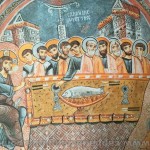 To the north, a winding stairway leads into the rectangular barrel vaulted narthex of the dark church. This church has a cruciform plan, the arms of which are cross vaulted. There is a centre dome, with four columns and three apses. This church gets its name from the tiny window in the narthex which only allows a small amount of light in. Due to the lack of light the colours of the frescoes are still vivid. The church and the narthex are richly decorated in scenes form the bible and the story of Jesus.
To the north, a winding stairway leads into the rectangular barrel vaulted narthex of the dark church. This church has a cruciform plan, the arms of which are cross vaulted. There is a centre dome, with four columns and three apses. This church gets its name from the tiny window in the narthex which only allows a small amount of light in. Due to the lack of light the colours of the frescoes are still vivid. The church and the narthex are richly decorated in scenes form the bible and the story of Jesus. 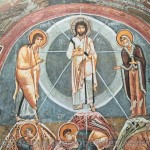 As in Elmali and Carikli churches there are also scenes from the old testament. The church dates back to the end of the 12th and beginning of the 13th centuries.
As in Elmali and Carikli churches there are also scenes from the old testament. The church dates back to the end of the 12th and beginning of the 13th centuries.
Scenes: Deesis, Annunciation, Journey to Bethlehem Nativity, Adoration of the Magi, Baptism, Raising of Lazarus, Transfiguration, Entry into Jerusalem, Last Supper, Betrayal of Judas, Crucifixion Anastasis Entombment Blessing and Mission of the Apostles, Ascension Hospitality of Prophet Abraham, Three Young Men in the Fiery Furnace and portraits of the saints.
The Carikli Church
 This two columned church(two other columns being in the form of pillars, is cross vaulted, and has three apses and four domes. The well preserved frescoes show the life of Jesus, the hospitality of the Prophet Abraham, and images of the saints and the church’s builders. As well as scenes also found in the churches of Elmalu and Karanlik, Carikli has some unique frescoes showing the way to the crucifix ion and the removal of Jesus from the cross. The figures are generally large The footprints pictured under the Ascension scene give the church its name, which means”with sandal The centre dome houses a picture of Jesus the Pantocrator with the busts of angels in the insets.
This two columned church(two other columns being in the form of pillars, is cross vaulted, and has three apses and four domes. The well preserved frescoes show the life of Jesus, the hospitality of the Prophet Abraham, and images of the saints and the church’s builders. As well as scenes also found in the churches of Elmalu and Karanlik, Carikli has some unique frescoes showing the way to the crucifix ion and the removal of Jesus from the cross. The figures are generally large The footprints pictured under the Ascension scene give the church its name, which means”with sandal The centre dome houses a picture of Jesus the Pantocrator with the busts of angels in the insets. 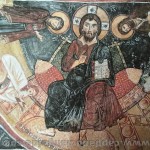 On the central apse is Deesis, on the north apse Mary and the infant Jesus, and on the south apse, a picture of the angel Michael. The church dates back to the end of the 12th and the begin ning of the 13th centuries
On the central apse is Deesis, on the north apse Mary and the infant Jesus, and on the south apse, a picture of the angel Michael. The church dates back to the end of the 12th and the begin ning of the 13th centuries
Scenes: Deesis nativity, Adoration of the Magi, Baptism Raising of Lazarus, Transfiguration, Entry into Jerusalem Betrayal by Judas, Way of the Cross, Anastasis Entombment, Ascension and portraits of the saints.
The Tokali Church
 This is largest known church in the region and comprises of four sectiones: The old church with one nave; the new church; the church ander the old church; and the chapel on the north side of the new church.
This is largest known church in the region and comprises of four sectiones: The old church with one nave; the new church; the church ander the old church; and the chapel on the north side of the new church.
The single nave, barrel vaulted old church, built in the 10th century, today acts as the ertrance to te new church. lts apse collapsed when the new church was added to the east ving.  Frescoes are to be found on the vault and at the top of the walls. The life of Jesus on separate panels running from right to left.
Frescoes are to be found on the vault and at the top of the walls. The life of Jesus on separate panels running from right to left.
Scenes at the old church: Portraits of the saints are in the centre of the vault. On the top of panel of the right wing are Annunciation, visitation, proof of virgin, journey to Bethlehem, and Nativity.  On the top panel of the left wing are, Adoration of the Magi, Massacre of te innocents, Flight into Egypt, presentation in the temple and Killing of Zacharias. On the middle panel of the right wing are, Pursuit of Elizabeth, Calling of John, Preaching of John, John and Jesus Christ, Baptism and Marriage in Casa. On the middle panel of the left ving are, Miracle of the wine, Miracle of the loaves and fish, Calling of the apostles, Healing of the blind man and Raising of Lazarus.
On the top panel of the left wing are, Adoration of the Magi, Massacre of te innocents, Flight into Egypt, presentation in the temple and Killing of Zacharias. On the middle panel of the right wing are, Pursuit of Elizabeth, Calling of John, Preaching of John, John and Jesus Christ, Baptism and Marriage in Casa. On the middle panel of the left ving are, Miracle of the wine, Miracle of the loaves and fish, Calling of the apostles, Healing of the blind man and Raising of Lazarus. 
The other Scenes: Entry into Jerusalem, Last Supper, Betrayal by Judas and Jesus before Pilate. Way of the cross, Death of Christ, Emtombment, Anastasis and the Ascension. Portraits of the saints, and Transfiguration is painted over the entrance. 
Scenes at the new church: The new church is transversally rectangular with a simple barrel vault. On this barrel vaulted nave is the story of Jesus in chronological order with mainly bright red and blue colours. The dark ( Cobalt ) blue colour serves to distinguish the Tokalı Church from the other churches.















